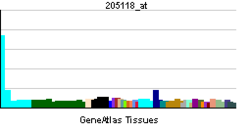Formil peptidni receptor 1
Prijeđi na navigaciju
Prijeđi na pretragu
| edit |
| Formil peptidni receptor 1 | |||
|---|---|---|---|
| Identifikatori | |||
| Simboli | FPR1; FMLP; FPR | ||
| Vanjski ID | OMIM: 136537 MGI: 107443 HomoloGene: 20466 IUPHAR: FPR1 GeneCards: FPR1 Gene | ||
| Pregled RNK izražavanja | |||
 | |||
 | |||
| podaci | |||
| Ortolozi | |||
| Vrsta | Čovek | Miš | |
| Entrez | 2357 | 14293 | |
| Ensembl | ENSG00000171051 | ENSMUSG00000045551 | |
| UniProt | P21462 | Q3UV01 | |
| RefSeq (mRNA) | NM_002029 | NM_013521 | |
| RefSeq (protein) | NP_002020 | NP_038549 | |
| Lokacija (UCSC) | Chr 19: 56.94 - 56.95 Mb | Chr 17: 17.58 - 17.59 Mb | |
| PubMed pretraga | [1] | [2] | |
fMet-Leu-Phe receptor ili N-formil peptidni receptor je protein koji je kod ljudi kodiran FPR1 genom.[1][2][3]
Vidi još[uredi | uredi kod]
Literatura[uredi | uredi kod]
- ↑ Boulay F, Tardif M, Brouchon L, Vignais P (Jul 1990). „Synthesis and use of a novel N-formyl peptide derivative to isolate a human N-formyl peptide receptor cDNA”. Biochem Biophys Res Commun 168 (3): 1103–9. DOI:10.1016/0006-291X(90)91143-G. PMID 2161213.
- ↑ Zhang Y, Syed R, Uygar C, Pallos D, Gorry MC, Firatli E, Cortelli JR, VanDyke TE, Hart PS, Feingold E, Hart TC (Feb 2003). „Evaluation of human leukocyte N-formylpeptide receptor (FPR1) SNPs in aggressive periodontitis patients”. Genes Immun 4 (1): 22–9. DOI:10.1038/sj.gene.6363900. PMID 12595898.
- ↑ „Entrez Gene: FPR1 formyl peptide receptor 1”.
Dodatna literatura[uredi | uredi kod]
- Graves V, Gabig T, McCarthy L, et al. (1992). „Simultaneous mobilization of Mac-1 (CD11b/CD18) and formyl peptide chemoattractant receptors in human neutrophils.”. Blood 80 (3): 776–87. PMID 1322204.
- Murphy PM, Ozçelik T, Kenney RT, et al. (1992). „A structural homologue of the N-formyl peptide receptor. Characterization and chromosome mapping of a peptide chemoattractant receptor family.”. J. Biol. Chem. 267 (11): 7637–43. PMID 1373134.
- Perez HD, Holmes R, Kelly E, et al. (1992). „Cloning of the gene coding for a human receptor for formyl peptides. Characterization of a promoter region and evidence for polymorphic expression.”. Biochemistry 31 (46): 11595–9. DOI:10.1021/bi00161a044. PMID 1445895.
- Bao L, Gerard NP, Eddy RL, et al. (1992). „Mapping of genes for the human C5a receptor (C5AR), human FMLP receptor (FPR), and two FMLP receptor homologue orphan receptors (FPRH1, FPRH2) to chromosome 19.”. Genomics 13 (2): 437–40. DOI:10.1016/0888-7543(92)90265-T. PMID 1612600.
- Murphy PM, McDermott D (1991). „Functional expression of the human formyl peptide receptor in Xenopus oocytes requires a complementary human factor.”. J. Biol. Chem. 266 (19): 12560–7. PMID 1712023.
- Boulay F, Tardif M, Brouchon L, Vignais P (1991). „The human N-formylpeptide receptor. Characterization of two cDNA isolates and evidence for a new subfamily of G-protein-coupled receptors.”. Biochemistry 29 (50): 11123–33. DOI:10.1021/bi00502a016. PMID 2176894.
- Wahl SM, Allen JB, Gartner S, et al. (1989). „HIV-1 and its envelope glycoprotein down-regulate chemotactic ligand receptors and chemotactic function of peripheral blood monocytes.”. J. Immunol. 142 (10): 3553–9. PMID 2541200.
- Jesaitis AJ, Naemura JR, Painter RG, et al. (1983). „Intracellular localization of N-formyl chemotactic receptor and Mg2+ dependent ATPase in human granulocytes.”. Biochim. Biophys. Acta 719 (3): 556–68. PMID 6129903.
- Prossnitz ER, Kim CM, Benovic JL, Ye RD (1995). „Phosphorylation of the N-formyl peptide receptor carboxyl terminus by the G protein-coupled receptor kinase, GRK2.”. J. Biol. Chem. 270 (3): 1130–7. DOI:10.1074/jbc.270.3.1130. PMID 7836371.
- Klotz KN, Jesaitis AJ (1994). „Physical coupling of N-formyl peptide chemoattractant receptors to G protein is unaffected by desensitization.”. Biochem. Pharmacol. 48 (6): 1297–300. DOI:10.1016/0006-2952(94)90168-6. PMID 7945424.
- Bommakanti RK, Dratz EA, Siemsen DW, Jesaitis AJ (1994). „Characterization of complex formation between Gi2 and octyl glucoside solubilized neutrophil N-formyl peptide chemoattractant receptor by sedimentation velocity.”. Biochim. Biophys. Acta 1209 (1): 69–76. DOI:10.1016/0167-4838(94)90138-4. PMID 7947984.
- Murphy PM, Tiffany HL, McDermott D, Ahuja SK (1993). „Sequence and organization of the human N-formyl peptide receptor-encoding gene.”. Gene 133 (2): 285–90. DOI:10.1016/0378-1119(93)90653-K. PMID 8224916.
- Jesaitis AJ, Erickson RW, Klotz KN, et al. (1993). „Functional molecular complexes of human N-formyl chemoattractant receptors and actin.”. J. Immunol. 151 (10): 5653–65. PMID 8228254.
- Särndahl E, Bokoch GM, Boulay F, et al. (1996). „Direct or C5a-induced activation of heterotrimeric Gi2 proteins in human neutrophils is associated with interaction between formyl peptide receptors and the cytoskeleton.”. J. Biol. Chem. 271 (25): 15267–71. DOI:10.1074/jbc.271.25.15267. PMID 8663057.
- Maestes DC, Potter RM, Prossnitz ER (1999). „Differential phosphorylation paradigms dictate desensitization and internalization of the N-formyl peptide receptor.”. J. Biol. Chem. 274 (42): 29791–5. DOI:10.1074/jbc.274.42.29791. PMID 10514456.
- Liang TS, Wang JM, Murphy PM, Gao JL (2000). „Serum amyloid A is a chemotactic agonist at FPR2, a low-affinity N-formylpeptide receptor on mouse neutrophils.”. Biochem. Biophys. Res. Commun. 270 (2): 331–5. DOI:10.1006/bbrc.2000.2416. PMID 10753626.
- Luu NT, Rainger GE, Nash GB (2000). „Differential ability of exogenous chemotactic agents to disrupt transendothelial migration of flowing neutrophils.”. J. Immunol. 164 (11): 5961–9. PMID 10820279.
- Bennett TA, Maestas DC, Prossnitz ER (2000). „Arrestin binding to the G protein-coupled N-formyl peptide receptor is regulated by the conserved "DRY" sequence.”. J. Biol. Chem. 275 (32): 24590–4. DOI:10.1074/jbc.C000314200. PMID 10823817.
- Ayala JM, Goyal S, Liverton NJ, et al. (2000). „Serum-induced monocyte differentiation and monocyte chemotaxis are regulated by the p38 MAP kinase signal transduction pathway.”. J. Leukoc. Biol. 67 (6): 869–75. PMID 10857861.